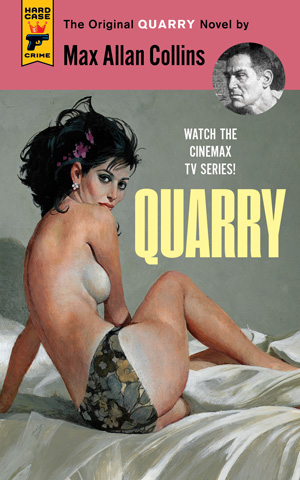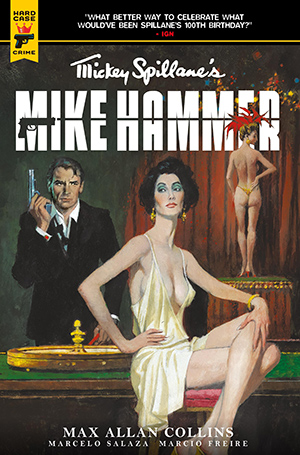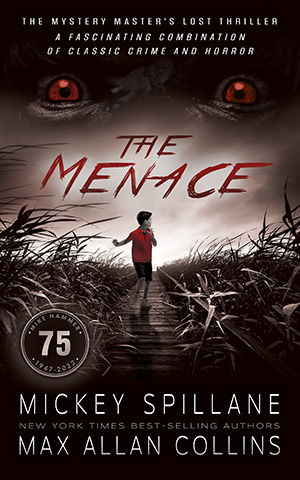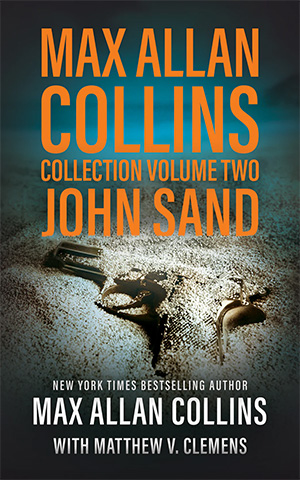Robert E. McGinnis died recently at 99, and that was still way too damn soon.
Bob McGinnis I spoke to only once, though he paid me a great, generous kindness, which I have talked about here previously but will touch on again, below.
McGinnis was the prime illustrator of mystery/crime paperback covers of the 20th into the 21st Century, and also a major contributor to movie-poster art. There are other contenders to that throne – James Avati, Robert Maguire, Barye Phillips and half a dozen others – but McGinnis was the king. As J. Kingston Pierce said at Crime Reads a few years ago, “McGinnis has turned out well over 1,000 covers, including many for books by John D. MacDonald, Carter Brown, Edward S. Aarons, Erle Stanley Gardner, Brett Halliday, Ed McBain, and Max Allan Collins….(H)e’s also illustrated dozens of movie posters…from the James Bond films to Dean Martin’s Matt Helm flicks.”
I do not take lightly being on a list of noir mystery writers that includes the luminaries on the J. Kingston Pierce list. Nor do I exaggerate when I say I had hoped, as an adolescent wanting to be a mystery writer, that one day I might be lucky enough to have a book of mine with a McGinnis cover.
McGinnis only did a few covers for Mickey Spillane novels. Mickey had just about every top illustrator in the game adorn his books from time to time – Avati, Phillips, Lu Kimmel, James Meese among them. During the heyday of the paperback original, McGinnis was noted for his stunning covers for the Brett Halliday “Mike Shayne” reprints at Dell. Several foreign markets used Shayne covers for various Spillane titles.
Meanwhile, at the movies, McGinnis was doing one stunning poster after another for the James Bond series, particularly the early Sean Connery entries, which were the best of the Bond bunch (McGinnis did other Bond movies, too, including most of Roger Moore’s). But Bond wasn’t McGinnis’ only movie poster work – among other famous films, he did the poster art for Barbarella, Breakfast at Tiffany’s and The Private Life of Sherlock Holmes (in addition to many others).

I will repeat myself – I spoke of this not long ago here – but after Charles Ardai published the first two Nolan novels (Bait Money and Blood Money under one cover as Two for the Money), I said I preferred writing new novels for Hard Case Crime. Charles said the advances would have to be the same as the reprint rate, and I said, fine – just put a McGinnis cover on my novel. That was half-joking, because Two for the Money had a weak cover among the usually stellar covers of HCC novels. But Charles called my bluff and got McGinnis to do the cover for The Last Quarry, which initiated the return of that character to a whole new series of novels, a short film, a feature film and a TV series (one season, but that counts).
As I’ve also mentioned here previously, when I called Bob McGinnis (Charles put me in touch) to tell him how thrilled I was with the cover for The Last Quarry – that after a career filled with mostly serviceable covers at best, having a McGinnis cover was a dream come true. He repaid that compliment by gifting me the original art, which hangs on my office wall, just up to my right as I write this.
When the aforementioned Quarry TV show sparked renewed interest in the character, Charles wanted to get the five early novels out as a group; but Hard Case Crime is noted for its strong pulp-flavored covers, which you might reduce to “guns and girls,” a certain cheeky politically incorrectness attached to their retro cover art. Only Charles didn’t have time to assign five artists to get five cover paintings, done all at once, and cover paintings were key. And he preferred to have the same artist do all five for some continuity.
I suggested to Charles that he call Bob McGinnis and see if any paintings might be available – perhaps things he had done for other publishers years ago, the rights to which might have come back to him. Charles did this, and discovered that McGinnis had five appropriate unused paintings in his inventory, all with the flavor of the old Mike Shayne covers. These apparently were the only such unsold paintings that still existed.

Charles snapped them up, and those Quarry novels all sport McGinnis covers as well as an inset image of Quarry plucked from Bob’s cover to The Last Quarry. In addition, three more of my novels (one of them a Spillane collaboration, The Consummata) have been blessed with McGinnis covers. I may have a record for mystery writers of my generation – ten Robert McGinnis covers on Max Allan Collins novels.
Astonishing.
One of the peculiarities of my association with Hard Case Crime is that Charles (and the folks at Titan, the parent company) will say “yes” to just a general idea of the book I have in mind to write. This means cover art gets assigned before the book is written. This happened twice with McGinnis covers – Quarry’s Choice and Quarry’s Climax – which had artwork come in before I’d written a page, and allowed me to write the women and the scenes McGinnis had imagined into the novels themselves.


That was an old pulp tradition that both Charles and I relished – a writer being handed a piece of art and asked to write a story around it. In his later years, McGinnis had a tendency to offer up slender, leggy beauties and that led to me including some women in my novels that varied from my standard blonde, Coke-bottle-waist bombshells (blame my beautiful blonde wife for that). The result was I had to work a little harder and be more creative, both good things.
I was blessed with one last McGinnis cover, when he painted a rather magnificent one for the Mike Hammer graphic novel The Night I Died, based on material written by Spillane and expanded and re-imagined by me. Mike Hammer: The Night I Died not only has two, count ‘em, two long-limbed McGinnis beauties, but a very credible rendition of Hammer himself, who has rarely appeared on book covers. (This graphic novel was also serialized in four issues, also with lovely covers but none by McGinnis).

What can I say about this incredible artist and genuinely nice man, who has entertained me for years and who provided some truly memorable covers to eleven works of mine?
How about – thank you.
Barb and I listened to the complete True Noir: The Assassination of Anton Cermak this past weekend. It’s four and a half hours long, so we divided it into two evenings.
Okay, I’m biased. But I think it’s terrific, thanks to director Robert Meyer Burnett, composer Alexander Bornstein, a stellar cast led by a fine Nate Heller in Michael Rosenbaum, casting director/producer Christine Sheaks, producer Mike Bawden, co-producer Phil Dingeldein, and a raft of talented professionals skilled in audio production.
If you are even a casual fan of my work – and in particular if, like me, Nate Heller seems to you to be my signature character (no offense, Quarry) – you will want to hear this production. The toughest critic I know – Barbara Collins – said, “I thought it would be good. But it blew me away. Wow!”
I mentioned Alexander Bornstein above, and he has provided True Noir with a full, memorable score. So memorable is it that not only will there be a soundtrack album, but it will be a 2-CD set. Our Blu-ray of the production, which will include the ten episodes of The History Behind the Mystery and a lot more, will likely include the soundtrack CD’s.
This is not a talking book or a radio show – it’s a movie for the ears and the mind.
Go to truenoir.co and hear for yourself.
M.A.C.










